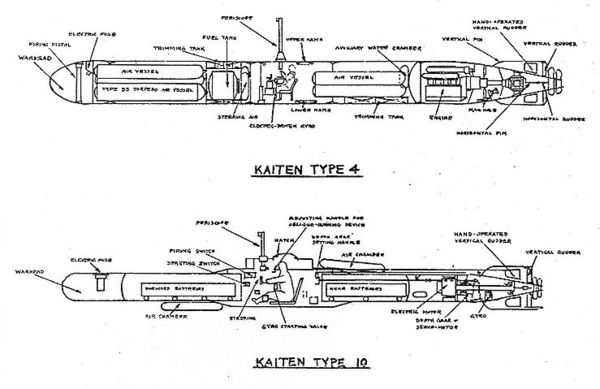사용자:WaffenSS/번역실/카이텐
- This article is about the suicide torpedo. In the martial art of taijutsu, a kaiten is a rolling maneuver.
- Kaiten is also a DoS program.
- Kaiten-Zushi is also the Japanese term for Conveyor belt sushi
The Kaiten (Japanese: 回天, translated "Change the World" or "Reverse Destiny") was a torpedo modified as a suicide weapon, and used by the Imperial Japanese Navy in the final stages of the Second World War.
Early designs allowed for the pilot to escape after the final acceleration toward the target, although whether this could have been done successfully is doubtful. There is no record of any pilot attempting to escape or intending to do so, and this provision was dropped from later production kaitens, so that once inside, the pilot could not let himself out. In the event that an attack failed, the kaiten was fitted with a control for self destruction.

Five models were designed, the types 1, 2, 3 and 4 based on the type 93 torpedo (24 inch oxygen/kerosene), and the type 10, based on the type 92 torpedo (21 inch electric). Types 2, 4 and 10 were manufactured in small numbers and never used. Prototypes of the type 3 may have been built, or it may have existed only as a concept.
Only the type 1, a one person model with a 3000 lb (1,360 kg) warhead, was used operationally. Almost 400 of these were built, with more than 100 of these sent on suicide missions. As well as the obvious advantage of providing guidance for the torpedo, these kaitens could be launched from a submerged submarine, unlike the unmanned type 93 torpedo which was deck launched from the surface. However they were not nearly as effective round for round as the highly successful type 93 torpedo on which they were based. The American sources state that the only sinkings achieved by kaiten attacks were the tanker USS Mississinewa on November 20 1944, and the USS Underhill on July 24 1945 (some Japanese sources give much larger numbers).

The type 2 was intended to have a crew of two, and so is often confused with the Japanese midget submarines used to attack Pearl Harbor and Sydney. However the midget submarines used in these attacks were each armed with two light torpedoes in individual tubes, and were intended to return to their mother ships after firing them. All kaitens, on the other hand, had only fixed warheads, and were single mission munitions. The quality of construction reflected this fundamental difference.

All kaitens were designed to be launched from either the deck of a surface ship or the deck of a submerged submarine. Provision was made for the crew to enter the kaiten from the submarine while submerged. Having a very limited depth capability themselves, when carried on a submarine deck the kaitens similarly restricted the diving depth of the submarine itself. This is one of several factors blamed for the very poor survival rate of submarines using them, eight submarines being lost while sinking only two enemy ships and damaging some others. A submarine carried from three to six kaitens.


See also[편집]
External links[편집]
- Kaiten Memorial Museum located at former kaiten base on Otsushima Island
- Kamikaze Submarine book by kaiten pilot who survived three missions
- USS Bowfin Submarine Museum & Park description accompanying the exhibit of a type 4 kaiten
- US Navy Historical Center account of the kaiten program, with diagrams of types 1, 2, 4 and 10
- Pictorial account of types 1 and 2 kaitens
- The Kaiten Mark II at the New Jersey Naval Museum in Hackensack, NJ
- HNSA Web Page: IJN Kaiten
- Human torpedo 回天 Kaiten (Japanese)
- Sheftall, M.G. (2005). 《Blossoms in the Wind: Human Legacies of the Kamikaze》. NAL Caliber. 480pp쪽. ISBN 0-451-21487-0.
|id=에 templatestyles stripmarker가 있음(위치 1) (도움말)

